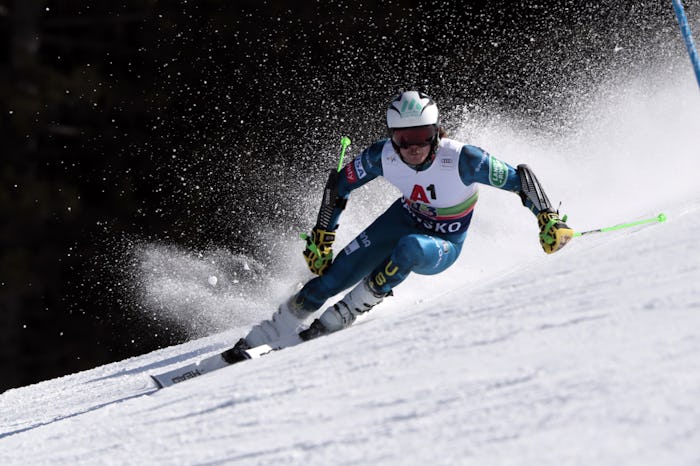Olympics

Here's How Fast Olympic Downhill Skiers Usually Go
Spoiler alert: It’s faster than your typical highway speed limit.
Even if you’re somebody who isn’t usually all that into sports, there’s something about the Olympics that captivates even the most unathletic and has everyone paying attention to events that aren't usually on anyone’s radar. With the 2022 Beijing Winter Olympics, you can expect to join the swaths of people watching their TVs anxiously as downhill skiers fly down mountains of snow at breakneck pace. But just how fast do downhill skiers go, anyway?
Watching the amazing athletic feats at the Winter Olympics always puts things in perspective: Many people can’t even walk on snow for all that long without falling down, let alone ski. These athletes are putting on skis and just casually making their way down a mountain of icy peril, facing possible injury or death, like it's no big deal. Of course, there are lots of different impressive skiing events at the Olympics, but downhill skiers, in particular, reach incredible speeds.
If you've ever watched a downhill skier make their way through a course, during the Olympics or at other events, you may have wondered just how fast they're actually going. Of course, it looks fast onscreen, but the numbers will no doubt impress you even more. Here’s all you need to know about how fast skiers really go.
How Fast Do Olympic Skiers Go?
Olympic downhill skiers can reach speeds of about 80 mph, according to the International Olympic Committee (IOC). That isn’t the top speed at all, though. Depending on the course and the athlete, downhill skiers can travel up to 95 mph on the fastest sections of their race.
For reference, recreational downhill skiers typically reach top speeds between 20 to 40 mph, as reported by NPR around the time of the Turin Winter Olympics, which doesn’t even come close to the speeds of Olympic athletes. In fact, Austrian athlete Klaus Kroell holds the record for top recorded speed during a downhill competition at 96.6 mph, and he didn't even win his race — he finished 19th.
These awe-inspiring speeds are tracked by a radar gun stationed at the fastest section of the downhill run, and typically, there's one stretch on almost every course where racers get to 80 mph or more, according to NPR. Of course, winning is not all about speed — it’s also about an athlete’s strategy while navigating the turns of a course, which is why someone who went as fast as record-holder Kroell might not actually win a downhill alpine competition.
To put those numbers into perspective, cheetahs can hit top speeds of about 75 mph — and they're the fastest land animal on Earth. Of course, they're at a disadvantage next to skiers, because we aren't putting cheetahs on aerodynamic, speed-enhancing skis. But given these speeds, most of the skiing Olympians in Beijing could pass the big cat during a downhill course — on the very off chance that a cheetah was sprinting nearby.
The Risks Of Speedy Skiing
The possibility of injury and death isn’t a joke, either. In 2017, French skier David Poisson, a top performer at the World Cup for years and the bronze medalist in downhill skiing at the 2013 world championships, died after he stumbled during a training run and hit a tree.
So, how do professional skiers deal with the possibility of severe injury or death while making their way down the hill at lightning speeds? Simple — they don't really talk about it. Bryce Bennett, one of the American downhillers who participated in the 2018 Winter Games in PyeongChang, told The New York Times, “More often than not, we won’t talk about the dangers. Because it doesn’t help. If you talk too much about it, it just becomes more of a reality.” Several athletes also told the publication Poisson's death shook them, but they got back out there and kept competing anyway.
Downhill Skiing At Beijing 2022
Given the thrill, risk, and absolute athleticism that it takes for these competitors to achieve what they do on the Olympic courses, it’s no wonder so many people tune in to watch. The first alpine skiing event at the 2022 Winter Olympics is set to take place on February 6 at the Xiaohaituo Alpine Skiing Field in the Yanqing District of China.
U.S. skier Mikaela Shiffrin is one to watch. Shiffrin already has two Olympic gold medals and recently broke the record for most race wins in a single discipline earlier in January. Other names to look out for include PyeongChang super-G winner Ester Ledecká from the Czech Republic (she also won gold in the parallel giant slalom in snowboarding at the same Olympics), Switzerland’s Michelle Gisin in the combined event, Switzerland’s 2021 World Champion in downhill Corinne Suter, France’s Mathieu Faivre in men's giant slalom and combined, and Austria’s Vincent Kriechmayr in super-G and downhill.
So, if you find yourself watching downhill skiing during the 2022 Winter Olympics, just keep in mind how fast these athletes are really going while you sit and watch from the comfort of your couch, moving approximately zero miles per hour.
This article was originally published on